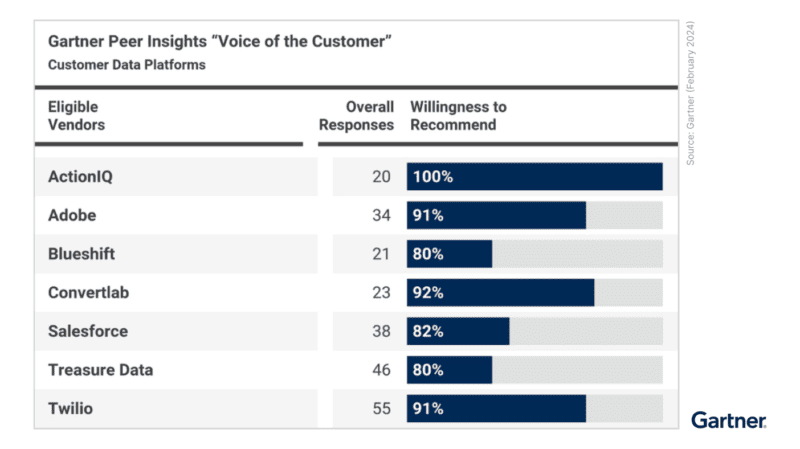Customer Identity Terminology From A to Z

You have to appreciate the irony: Asking someone to define the concepts around “customer identity” — the entire point of which is helping brands understand who someone is and what they’re doing with greater certainty — will get you a grab bag of uncertain answers.
Take “identity resolution,” for example. Depending on who you’re talking to and their perspective, the definition can change drastically. Why? Because people tend to change what something means to suit their roles, market positions or personal opinions.
The result is confusion and misalignment. And in a world where understanding customer identity is becoming even more business-critical, brands can’t afford to be misinformed.
That’s why we’ve put together a list of the most important customer ID terms below. Keep reading to find out what they mean and why they matter.
Customer Identity Terminology from A to Z
Identity Resolution
Identity resolution is the process of integrating multiple disparate data sets together to create a comprehensive and addressable marketing profile. This means ingesting and integrating different sets of data around a single person.
The process has multiple components, all of which we’ll break down in the sections below. The specifics depend partly on the data sources used and whether third parties are involved.
In short, identity resolution is essential to providing personalized, relevant and impactful customer experiences (CX) across marketing, sales and customer service. That means customer identities need to be:
- Accurate: You need the correct details to design a tailored experience
- Complete: You need all the details to design a tailored experience
- Addressable: You need the ability to actually deliver the experience
Identity Stitching
Identity stitching is the process of ingesting, matching and deduplicating profiles from among multiple data sources. These could include anything from web and mobile streams to customer relationship management (CRM) tools. (Read all about it: CDP vs CRM.)
And when you’re stitching together owned data sources that cover specific customer touchpoints — whether experiential or transactional — there are two types to be aware of:
1. Deterministic Identity Stitching
This type is when fields associated with a specific profile are consistent from one system to the next.
For example, if your CRM includes a profile for “Zach” and your enterprise resource planning tool does as well, you can combine them into a single profile with 100% confidence.
2. Probabilistic Identity Stitching
This type is when a specific profile in one system may possibly match a different profile in that system or in other systems.
For example, the name “Zach” may be entered in some systems as “Zachary,” or misspelled in another system as “Zack.” By using certain algorithms to compare different profiles, you can determine with some degree of confidence whether these profiles can be combined into a single one.
Identity Syncing
Identity syncing is the process of tracking web and mobile behaviors and using them to resolve identities and/or aggregate identifiers from associated systems in real or near real time. This is the primary way of making profiles within a customer data platform (CDP) addressable.
Watch the video below to learn more about how CDPs, MDMs and other technologies help resolve customer identities:
Identity Enrichment
Identity enrichment is the process of either expanding the truth set of a profile or cleansing specific fields and attributes associated with it. This is usually done by syncing second-party and/or third-party data sources with an identity-stitched, first-party profile.
For example, we may have a solid understanding of “Zach” based on his records within company-owned systems (first-party data), but enriching his profile with other data sources (second- and third-party data) would help us create a more complete profile, adding details such as media preferences, content affinities and general demographic attributes.
Identity Graph
Identity graphs are the primary output of identity resolution. They act as the underlying data structure and contain all the elements that make up a marketing profile.
This includes event-specific behaviors, attributes derived from those behaviors, second-and-third party enrichment information, models based on all of the above and identifiers that correlate with a specific profile.
Put simply, an identity graph is the backbone of a CDP’s ability to activate personalized customer experiences.
For example, say “Zach” visits a brand’s website, opens an email from the brand and then purchases one of its products. Within such a session there are events that are defined as behaviors (i.e., email open) and identity signals that correspond to those events (i.e., email, first name, last name).
These behaviors and identifiers come together as part of an identity graph that comprises Zach’s profile. This enables marketers to address Zach more effectively by tailoring experiences to be more relevant. There can be hundreds of other identifiers associated with Zach as he moves through varying systems in the customer journey. (Read our posts about behavioral segmentation and customer journey management for more.)
There are four types of identity graphs:
1. Pseudo-Anonymized Identity Graph
Pseudo-anonymized identity graphs are ones that don’t have personally identifiable information (PII) associated with a profile, but instead have other addressable identifiers derived from third-party sources.
This allows marketers to provide personalized customer experiences in ways that can be tied back to those identifiers, such as programmatic media and paid social media advertising. (Watch the webinar: “A Post-Cookie Approach to Programmatic Media: How HP Is Taking a CDP-Centric Strategy.“)
2. Known Identity Graph
Known identity graphs are ones that have PII fields associated with a profile and are able to identify a customer or prospect who has signed up and given permission to share their data for the purposes of personalized experiences and/or marketing communications.
3. Private Identity Graph
Private identity graphs are ones that are built in house by businesses. They’re typically designed using inputs from first-, second- and third-party data sources.
4. Vendor Identity Graph
Vendor identity graphs are ones that are built and managed by data providers. Primary players in this space include Neustar, Merkle, Acxiom and LiveRamp.
These graphs are generally designed using inputs from second- and third-party data sources. They’re sometimes referred to as identity spines. They can also be referred to as authoritative graphs because they can be used as authoritative data sources for identity enrichment.
Identity Spine
Identity spines are organizations that have a database of U.S.-based consumers and collect identifiers, signals and attributes associated with specific consumer identities within their database.
By integrating a CDP with them, companies can build a more comprehensive understanding of their customers by enriching their identity graphs with an identity spine.
The term “identity spine” is practically synonymous with vendor identity graphs.
360 Customer View
A 360 customer view — also referred to as a customer 360 or single view of customer — is often erroneously conflated with identity graphs.
Instead, it should be viewed as the visual representation of an identity graph’s underlying data structure. It’s what you’ll see when looking at a specific marketing profile.
The term “golden record” is often bandied about when talking about 360 customer views and CDPs, but it shouldn’t be. A golden record is a master, authoritative truth set that drives critical business functions.
For example, in a retail context, the golden record may include financial, product and customer records that operations teams can access. Customer 360s and CDPs don’t serve this purpose, although they often connect to the systems that do.
Identity Signals
Identity signals, also known as identity bread crumbs, are a type of attribute or piece of metadata that can be associated with a specific action or event and point back to a specific profile. Signals can be both highly determinate (i.e., hard signals), such as emails if a person signed up for a newsletter, and probable (i.e., soft signals), such as a device ID that could aid in the process of creating a persistent, addressable profile.
As this profile goes through a defined customer journey, from awareness, consideration, purchase, retention and beyond, these hard and soft identity signals are a key element in building up an identity graph. (Read our post about customer journey stages.)
Addressability
Addressability is the ability to deliver an experience to a specific identity. It enables marketers to identify a certain person and then engage them on a specific channel in a specific way.
Without addressability connected to the identity graph, marketers wouldn’t be able to take action on customer data and provide personalized experiences.
Cookies
Cookies are files with small amounts of data that can be used to identify a person at the device level and are used to track behaviors and preferences. In the context of identity resolution, first-party and third-party cookies play a vital role.
1. First-Party Cookies
First-party cookies are created by the websites a person visits. They keep track of personal preferences specific to that site.
Given this core function, a customer ID derived from first-party cookies is considered to be stable, consistent and accurate. This makes first-party cookies an essential signal for identity graphs.
2. Third-Party Cookies
Third-party cookies are created by a website other than the ones a person visits. They track behaviors across the web.
While third-party cookies were previously the backbone of many companies’ digital ad targeting strategies — traditionally through the use of tools such as data management platforms (DMP) — they and the tools built to manage them are being phased out due to regulatory pressures across web browsers, device operating systems and global governments.
Going forward into a cookieless future, marketers must leave DMP marketing behind and rely on a first-party data strategy instead.
Onboarding
Onboarding is the process of sending your first-party customer data to a separate online environment to be matched with digital identifiers. There are two primary use cases here:
- The first is sending customer data to a DMP where it can be blended with third-party data for the purposes of either lookalike modeling or extracting insights.
- The second is sending customer data to a media onboarder where it’s matched to specific paid media channels for the purpose of advertising to certain audience segments.
As marketers move away from reliance on third-party cookies and DMPs, the latter use case will prove to be future-proof and flexible.
Cohorts
A cohort is a group of people, such as a household, a small geographical area or a common set of behaviors, that act as a representation of underlying individuals. A cohort could be used for hundreds or even thousands of people. Each cohort is assigned a cohort ID by the platform that generates it to make it addressable within that platform.
In the context of a CDP, there is conceptual overlap between a cohort and a segment. Both are groupings of individuals in relation to a type of commonality for the purposes of delivering a relevant experience.
The key difference between a cohort and a segment is that cohorts would be more strictly confined as a means of driving personalization and measurement among unknown/anonymized users. (Read our blog post about customer segmentation.)
Cohorts are often used for media attribution and are seen as an emerging privacy-compliant replacement for some use cases previously powered by third-party cookies.
Fingerprinting
Fingerprinting is the process of collecting information on a device or browser for the purpose of identification. It can be used to fully or partially identify individual devices, even when third-party cookies are not involved. Various forms of fingerprinting have been around since the 1990s and used for everything from fraud protection to advertising.
It’s a way of enabling identification and addressability among unknown visitors to a website. The most common use cases for fingerprinting are paid advertising and website personalization retargeting, which allows brands to serve up content and experiences relevant to site visitors based on their previous actions.
With third-party cookie deprecation, fingerprinting has taken on more prominence. However, it comes with its own controversy due to a lack of transparency and/or explicit consent provided by consumers, as well as Apple and Google actively restricting its use.
Remember: Identity underpins everything brands do, from marketing campaigns to customer support. The imperative for organizations now is empowering their business teams to access and take action on customer identities to give people what they want: personalized, impactful and real-time CX.
Learn More About Customer Identity
Download our CDP Market Guide or reach out to our experts to see how the right technology can help you resolve customer identities and transform data into superior, seamless CX.





